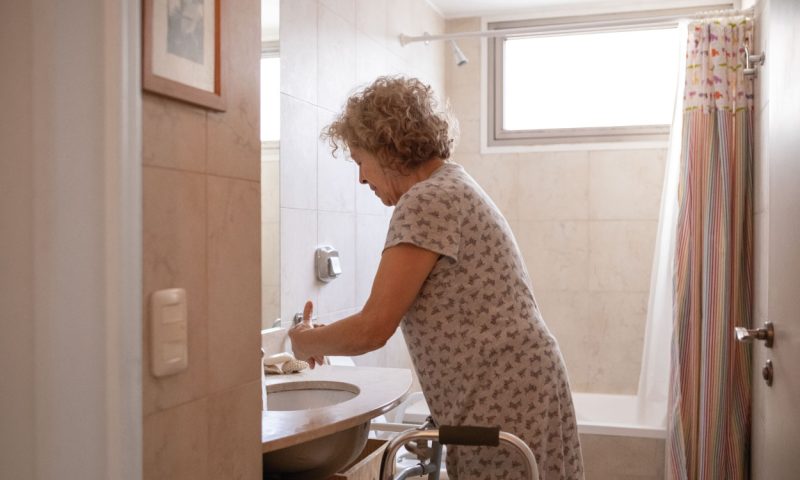Designing a safe and accessible bathroom for elderly family members is about more than just convenience; it’s about ensuring their independence and minimising the risk of accidents at home. Whether you’re hosting elderly parents or future-proofing your home, a few thoughtful adjustments can make all the difference.
This guide explores practical upgrades, from walk-in showers to grab rails, that’ll turn your bathroom into a safe, functional space that works for everyone – without compromising on comfort or style.
Why Accessibility Matters in Bathrooms
Slippery flooring, high fixtures, and hard-to-reach storage can make bathrooms a challenging space for elderly individuals. According to the NHS, falls are a leading cause of injury in older adults, with many occurring in bathrooms due to wet surfaces and lack of support.
Ensuring your bathroom is both safe and user-friendly helps protect loved ones without compromising on style or comfort. And with a growing number of multigenerational homes in the UK, these upgrades are more relevant than ever.
Practical Solutions for a Safer Bathroom
Here’s how you can adapt your bathroom to prioritise safety and accessibility:
Install a Walk-In Shower
A walk in shower is a game-changer for accessibility, removing the need to step over high bathtub edges. They’re spacious enough to accommodate shower chairs or mobility aids while reducing the risk of slips and falls. Look for designs with anti-slip flooring, easy-to-reach controls, and detachable showerheads for added convenience.
Pro Tip: Consider adding a thermostatic shower valve. This prevents sudden temperature changes, reducing the risk of scalding.
Switch to a Walk-In Bath
For those who prefer baths, a walk in bath offers a safe alternative. Featuring a low-entry door, they eliminate the need to climb in and out, and many models include built-in seating and grab handles.
Some even provide relaxing extras like hydrotherapy jets to soothe muscle pain. These features can be especially beneficial for users with arthritis or limited mobility.
Add Grab Rails for Extra Support
Grab rails are an affordable yet essential addition to any accessible bathroom. Install them near key areas such as:
- The toilet
- Inside and outside the shower or bath
- Around the sink
Choose rails made from durable, anti-slip materials, and position them at heights that align with the needs of your elderly family member.
Styling Tip: Modern grab rails are available in sleek, minimalist designs, proving safety doesn’t have to mean sacrificing aesthetics.
Widen the Doorways
Standard doorways can be restrictive for those who use wheelchairs, walkers, or mobility aids. Widening the doorway to at least 32 inches ensures effortless access, making the bathroom more inclusive. Sliding doors can also be a great space-saving solution. It’s a smart investment if you’re planning wider renovations.
Opt for Comfort-Height Toilets
The typical lower height of standard toilets can be difficult for elderly individuals to use comfortably. Comfort-height toilets are a practical upgrade, as they sit higher off the floor, making sitting down and standing up far easier.
Quick Fix: If you’re not ready to replace your toilet, add a raised toilet seat for similar functionality. These are easy to install and remove as needed.
Improve Flooring Safety
Slippery bathroom floors are a significant hazard. Replace tile with non-slip flooring materials like vinyl, rubber, or textured tiles. For an extra layer of safety:
- Add non-slip mats near the shower, bath, and sink.
- Avoid thick rugs that may cause tripping.
Also, consider underfloor heating to keep the space dry and reduce the risk of damp-related slipping.
Additional Tips for Future-Proofing Your Bathroom
Use Sensor-Activated Lighting
Poor lighting can increase the risk of falls, especially for those with impaired vision. Sensor-activated lights brighten the space automatically when someone enters, making the bathroom instantly safer. These lights are also energy-efficient and ideal for night-time visits.
Accessible Storage Solutions
Keep essentials like toiletries and towels within easy reach by installing pull-out drawers or adjustable shelving. This reduces the need for stretching or bending, which can be risky for elderly users. Think about using colour-coded labels or clear containers for easier identification.
Temperature Regulation
Add anti-scald devices to faucets and showerheads to automatically regulate water temperature. These devices not only prevent burns but also provide peace of mind. Combine them with clearly marked hot and cold taps for added clarity.
Combining Style with Accessibility
The good news is that modern accessible bathroom solutions blend functionality with style. From contemporary walk-in showers to sleek grab rails, your bathroom can remain beautiful and chic while offering the safety your loved ones deserve. Many features are now customisable, helping your space feel tailored rather than clinical.
Take Steps Towards a Safer Home
Creating an accessible bathroom is a thoughtful way to show care for your elderly family members while ensuring everyone feels secure and comfortable at home. By incorporating these updates, you can minimise risks and make everyday routines significantly easier.
Love the idea of an accessible yet stylish bathroom but not sure where to start? A professional bathroom designer can help assess your space and recommend solutions tailored to your needs and budget.
The post Essential Bathroom Upgrades for Senior Safety appeared first on UK Home Improvement.
